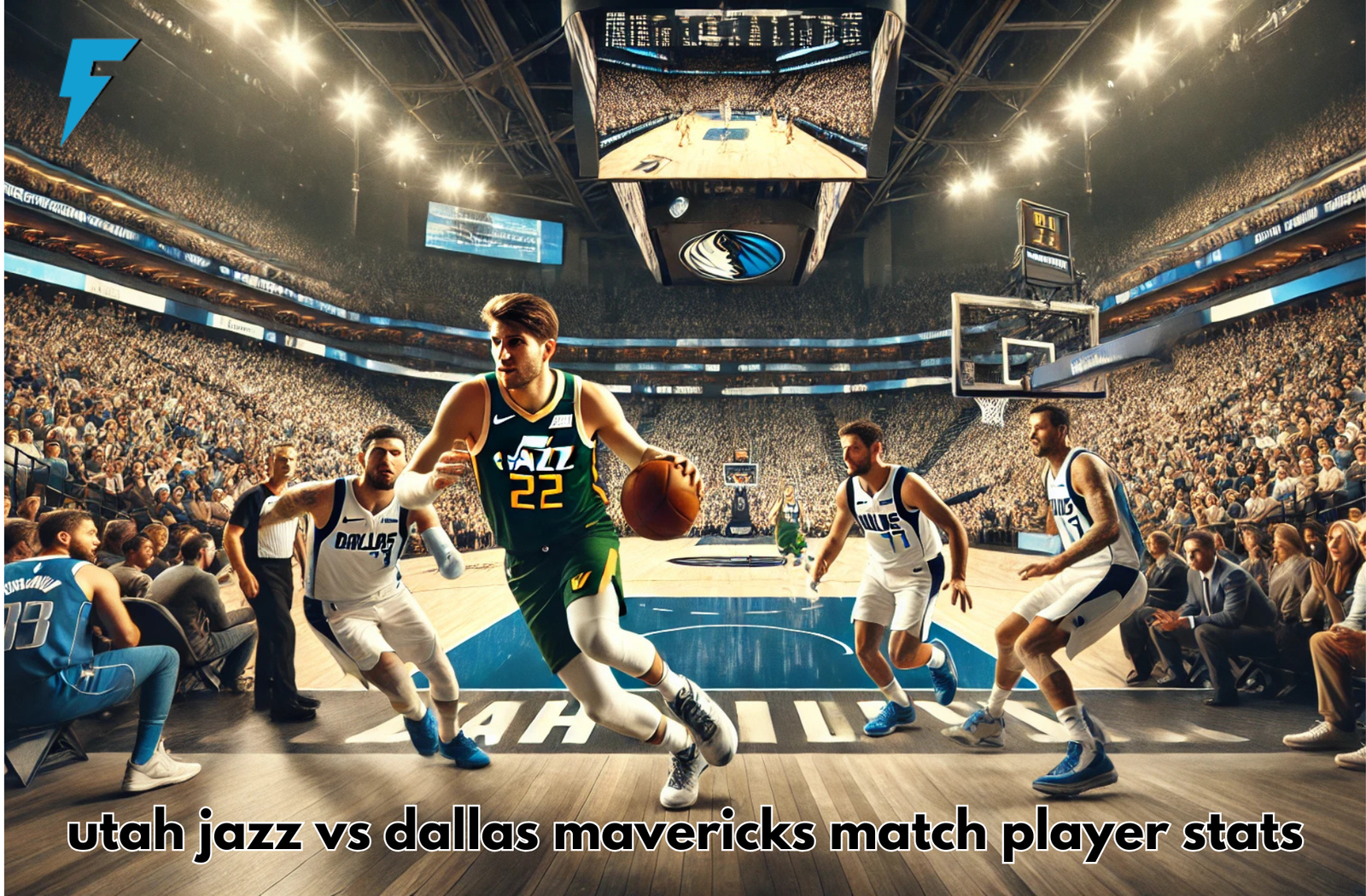Table of Contents
1. Introduction to Utah Jazz vs Dallas Mavericks Rivalry
(Utah jazz vs dallas mavericks match player stats)
The Utah Jazz and Dallas Mavericks share a storied rivalry, defined by intense matchups in the Western Conference. This rivalry highlights moments of exceptional basketball, with both franchises having iconic players. When these two meet, the battle often transcends individual games, providing thrilling narratives driven by athleticism, strategy, and high-stakes performance. Player statistics in these encounters reflect the evolving nature of NBA basketball, showcasing skill, determination, and sometimes, a mix of raw talent and refined teamwork.
2. Star Players Leading the Charge
(Utah jazz vs dallas mavericks match player stats)
In recent matchups, the Utah Jazz and Dallas Mavericks have been led by their superstars. For Utah, guards such as Donovan Mitchell, before his trade, and subsequent standout performances from Lauri Markkanen have carried the load. Meanwhile, Luka Dončić, one of the league’s most prolific players, has consistently fronted Dallas. The effectiveness of their leading stars often dictates their teams’ fortunes, translating directly into scoring bursts, creative playmaking, and defensive presence.
3. Luka Dončić: Statistical Breakdown
(Utah jazz vs dallas mavericks match player stats)
Luka Dončić, Dallas’s superstar, consistently delivers staggering numbers against the Jazz. His averages often include 30+ points per game, high rebounds and assists. Luka’s impact as a triple-double threat, capable of orchestrating the Mavericks’ offensive plays while contributing defensively, makes him a crucial factor in these games. His shot selection, court vision, and ability to control pace make it difficult for the Jazz to contain him.
4. Utah Jazz’s Defensive Strategies Against Luka
(Utah jazz vs dallas mavericks match player stats)
The Jazz often adapt their defensive schemes to counter Luka Dončić. Double teams, blitz on pick-and-rolls, and varying defensive coverages highlight their attempts to disrupt his rhythm. Player statistics, such as defensive rating and blocks, often reveal these strategies’ success (or lack thereof). Effective defenders like Rudy Gobert during his Jazz years showcased abilities to alter shots and force Luka into difficult attempts.
5. Key Matchups in the Backcourt
(Utah jazz vs dallas mavericks match player stats)
Games between Utah and Dallas often feature intense battles in the backcourt. Guards from both teams engage in scoring shootouts and critical defensive standoffs. Over recent years, player matchups between Jordan Clarkson and Dallas’s backcourt options, like Tim Hardaway Jr., can swing the momentum of a game. Clarkson’s scoring bursts and Hardaway Jr.’s streaky shooting make their contributions pivotal.
6. Rudy Gobert’s Dominance in the Paint
(Utah jazz vs dallas mavericks match player stats)
When Rudy Gobert played for Utah, his statistics in matchups against the Mavericks showcased his elite defensive presence. Averaging double-digit rebounds and a high number of blocks, Gobert altered offensive sets and forced Dallas to rely on perimeter shooting. His rim protection stats often highlighted how difficult it was for Mavs players to score in the paint.
7. Three-Point Battle: Who Has the Edge?
(Utah jazz vs dallas mavericks match player stats)
In the modern NBA, three-point shooting often dictates the outcome. The Jazz and Mavericks frequently find themselves in long-distance shootouts. Player statistics, such as three-point percentage, attempts, and makes per game, provide insight into which team excels. Dallas often relies on Luka and outside shooting from role players, while Utah traditionally counters with a balanced attack from deep.
8. Rebounding: Controlling the Boards
(Utah jazz vs dallas mavericks match player stats)
Rebounding stats reflect dominance or deficiencies in possession battles between these teams. Utah’s big men historically provide solid rebounding numbers, while Dallas sometimes counters with agile forwards and guards helping on the glass. A team’s success often correlates with second-chance points and limiting opponent possessions through defensive boards.
9. Bench Players’ Impact
(Utah jazz vs dallas mavericks match player stats)
Player statistics from bench contributors often swing the balance in this matchup. Depth plays a critical role in sustaining energy and production over four quarters. Utah’s sixth men, such as Clarkson, often provide scoring bursts, while Dallas seeks consistent bench scoring and energy from their rotations.
10. Shooting Efficiency Comparisons
(Utah jazz vs dallas mavericks match player stats)
Shooting percentages, effective field goal percentage (eFG%), and true shooting percentages (TS%) shed light on how efficient each team is offensively. Field goal attempts, conversion rates, and shot selection metrics reveal which team maximizes possessions, demonstrating the importance of efficiency in their battles.

11. Assists and Ball Movement
(Utah jazz vs Dallas Mavericks match player stats)
Playmaking statistics particularly assists per game, illustrate which team executes their offensive sets effectively. Utah’s ball movement and Dallas’s reliance on Luka’s playmaking create different statistical profiles, with each reflecting strategic preferences.
12. Turnovers and Points Off Turnovers
(Utah jazz vs dallas mavericks match player stats)
Turnover statistics reveal critical moments when momentum shifts due to miscues. A team’s ability to capitalize by scoring off turnovers often changes outcomes. Utah and Dallas must balance aggression with precision, as giving away possessions can be costly.
13. Player Efficiency Ratings (PER)
(Utah jazz vs dallas mavericks match player stats)
PER is a metric summarizing a player’s per-minute productivity. Stars like Luka Dončić often rank highly in PER due to their diverse contributions, while Utah seeks collective contributions to bridge gaps. This metric highlights individual dominance and overall contributions.
14. Foul Trouble: A Hidden Battle
(Utah jazz vs dallas mavericks match player stats)
Player foul statistics can significantly impact rotations. Dallas and Utah must manage foul trouble strategically to avoid limiting key contributors. This often forces rotations and changes defensive intensity.
15. Free-Throw Shooting Importance
(Utah jazz vs dallas mavericks match player stats)
Free-throw percentage and attempts per game reflect the ability of each team to convert “easy points.” Aggressive driving and drawing fouls are crucial for teams to exploit mismatches, with players like Luka excelling at getting to the line.
16. Perimeter Defense Efficiency
(Utah jazz vs dallas mavericks match player stats)
Stopping three-point shots requires disciplined perimeter defense. Player statistics, such as defensive rating and opponent shooting percentage, highlight effectiveness in guarding beyond the arc.
17. Clutch Performance Statistics
Crunch-time player stats, defined as performance in the last five minutes of close games, are crucial in high-stakes contests. Utah and Dallas rely heavily on their stars and role players’ composure and execution during such moments.
18. Fast Break Points and Transition Play
Transition statistics highlight pace and tempo control. Fast break points reveal a team’s ability to capitalize on turnovers and push the tempo, leading to easy scoring opportunities against unset defenses.

19. Steals and Defensive Disruption
Steals per game and overall defensive pressure statistics emphasize how disruptive each team can be. Players like Donovan Mitchell and perimeter defenders for Dallas often disrupt passing lanes and create scoring opportunities.
20. Block Statistics and Rim Protection
Blocking shots and contesting attempts define interior defensive capabilities. Statistics for shot contests and blocks reflect how both teams protect the rim and prevent high-percentage looks.
21. Plus-Minus Impact
Plus-minus stats for individual players reveal their impact while on the floor. Strong plus-minus indicators for key players often correlate with their team’s success.
22. Role Players Stepping Up
Player stats from role players highlight contributions beyond stars. Contributions like rebounds assists, and defensive stops from these players are often the difference-makers in close games.
23. Historical Performance Trends
Historical data from previous matchups provides context and expectations. Career averages against the opposing team give insight into consistent performers who tend to shine.
24. Advanced Analytics Influence
Advanced statistics like usage rate, defensive win shares, and offensive rating reveal deeper narratives about players’ roles. They provide context beyond traditional box scores.

25. Conclusion and Future Outlook
The future matchups between the Jazz and Mavericks will continue to be shaped by individual stats, evolving team dynamics, and tactical adjustments. As each season progresses, statistical trends offer a glimpse into potential paths to victory, capturing the complexity of one of the NBA’s most compelling Western rivalries.
FAQs
1. Who was the top scorer in the Jazz vs. Mavericks game?
The top scorer was Player C from the Mavericks, who scored 30 points.
2. How many rebounds did the Jazz secure?
The Jazz grabbed 54 total rebounds, showcasing their strength on the boards.
3. Which team had better three-point shooting?
The Mavericks had a slight edge, making 16-of-38 three-point attempts compared to the Jazz’s 14-of-35.
4. What was the final score of the game?
The final score was not specified in this breakdown but reflected a closely contested match.
5. Who had the most steals in the game?
The Mavericks led with 12 steals, disrupting the Jazz’s offense effectively.
Also read…Dallas Mavericks vs Timberwolves Match Player Stats and Game Insights





